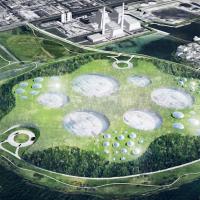It’s been said that planting a trillion trees could be just what we need to turn the tide of climate change. Scientists estimate that natural solutions, such as reforestation projects, can contribute at least 30% of the fight against global warming.
“Trees are basically designed to suck carbon out of the air.”
Susan Cook-Patton Forest Restoration Scientist at The Nature Conservancy
Forests currently take up about one-third of earth’s land, but it used to be much more. As civilization expanded, we began to encroach on forests to use the land for agriculture, mining, drilling, and more. In fact, some sources say humans have eliminated nearly half of the world’s trees thus far.
The Convincing Case for Forestation
The removal of forests, also known as “deforestation,” affects not only the animals who live in them but the people who live around them as well. Much of the world’s rural poor rely on forests and the forestry industry for income and basic necessities.
The World Wildlife Fund reported that 80% of land animals and plants call forests “home,” from orangutans to tree frogs. Deforestation has already contributed to the endangerment of many animals, such as the Hawaiian crow that is now extinct in the wild.
Trees prevent soil erosion and provide the essential cover that many species need to thrive. Humans benefit from their ability to capture water as well, as they reduce the risk of landslides and flooding.
Not convinced about the importance of forests just yet? Consider the impact that trees have on the air we breathe. Through photosynthesis, trees release oxygen into the air that we need to survive. One report estimates that a single tree can release 260 pounds of oxygen every year.
In a sense, trees are Mother Nature’s vacuum – they suck up harmful carbon dioxide and pollutants. Human activities have increased the amount of greenhouse gases in the air, driving climate change, but trees help keep the air clean. It’s perhaps one of their most important contributions to the planet.
Growing Forests to Fight Climate Change
This is where Plant for the Planet comes in, one of the world’s leading tree planting organizations.
Plant for the Planet is an international forestation movement with the goal of planting a trillion trees all around the world. What started in Germany with one nine-year-old’s vision evolved into over 100,000 participants in 193 countries.
Plant for the Planet aims to plant a million more trees than the year before, each and every year. And Campeche, Mexico is just one of their strategically chosen planting locations, where trees grow four times faster than they do in Central Europe.
Campeche is on the Yucatan Peninsula, in southeast Mexico. In a small town called Constitución, over 100 plantation workers are currently planting six native, mahogany tree species where there once was a forest.
Plant for the Planet first came to the state of Campeche in 2016 and since then, the team has planted half a million trees.
What is Reforestation?
Reforestation is essentially the practice of growing forests where they previously existed naturally, but restocking a forest isn’t a quick undertaking.
Tree planting organizations like Plant for the Planet put a lot of care and attention into their methods to ensure the trees’ survival. At Plant for the Planet, reforestation efforts begin in the nursery, where workers grow more than four million seedlings with the highest quality standards.
Once the trees reach a certain height in the nursery, they’re extracted and sent out to be planted. Forestry workers also care for the newly planted trees by pruning them and clearing out weeds. These reforestation projects have created jobs for locals that aren’t just a source of income. Local workers feel a sense of purpose, knowing their efforts play a big role in fighting the climate crisis.
This project is a working example of what forest restoration efforts everywhere could look like and it demonstrates just how easy it is to efficiently plant trees on a large scale. Plant for the Planet urges others to join their efforts and presents a variety of ways to get involved, including attending a Youth Summit to learn more and becoming a “Climate Justice Ambassador.”
The Trail Blazers of Global Reforestation Projects
In 2011, the United Nations Environment Programme (UNEP) handed over the reins for their Billion Tree Campaign to Plant for the Planet. The organization transformed the Billion Tree Campaign into the Trillion Tree Campaign and developed an animated, global tree counter that motivates other individuals and tree planting organizations to get involved.
The tool currently shows that just under 14 billion trees have been planted since 2006. Users can also see where trees have been planted, find potential locations for new reforestation projects, and register their own planted trees.
Today, Plant for the Planet plants a new tree every 15 seconds. The efforts of tree planting organizations are a source of hope for the future of our climate, with the bonus of providing ecological benefits far beyond carbon sequestration.
For more interesting news about the people and ideas that are changing our world, subscribe to Freethink.


